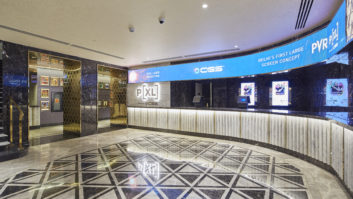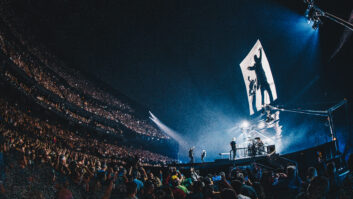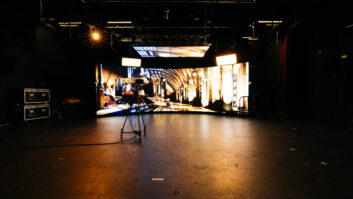They say that it’s a sign you’re getting old when policemen start to look young. When I meet implausibly fresh-faced Tom Barnett of Kaleidescape, I wonder if the same applies to senior directors of marketing.
We move to the business in hand – a briefing about some new developments from the residential movie server company. The first talking point is CinemaScape – “a feature born out of desire to give people the best viewing experience in a 2.35 theatre,” says Barnett. With a 2.35:1 aspect ratio becoming very common in home theatre systems – nearly 90% of the shortlisted installations in the CEDIA Electronic Lifestyles Award were of this type, he points out – Kaleidescape has produced a feature that enables users to switch aspect ratios without fitting the projector with a retractable anamorphic lens.
Thanks to CinemaScape, the Kaleidescape Movie Guide can fit onto a 2.35 screen without the viewer having to scroll horizontally to read some of the data. Also, it makes switching between content with different aspect ratios much smoother. Adding or removing a lens requires a change in projector mode – which can sometimes produce momentary purple and green flashes on the screen – and there’s also a time delay of a few seconds as the lens is moved. This may not be a particular concern if you’re settling down to watch a full-length movie, but is more significant if you’re playing shorter clips.
Which brings us neatly to the second new feature – Kaleidescape Scenes. Within its Movie Guide for each title, Kaleidescape offers a list of recommended scenes – highlights of the movie – for viewers to jump to. For a while, users have had the opportunity to mark and name scenes themselves; however, the company has found take-up to be limited. At the end of August, more than 4,000 scenes from 700 of the most popular titles had been added to the system, and more are being added every day.
Don’t people want to watch whole movies, rather than selected highlights? “[Watching the full feature] is how people think about DVDs and Blu-ray Discs, but I think a lot of that is just that that’s what’s convenient to do,” says Barnett. “It’s not well organised for going and finding things [from multiple discs], so you don’t think about it the same way you think about your music, where you have random access and you would listen to a single song. So Scenes is a new and novel proposition.”
It’s certainly a different way of using your media collection. While it may not be to everyone’s taste, I suspect that people who are regular consumers of YouTube content will be more comfortable with this mode of viewing. And, as Kaleidescape’s publicity material points out, watching Scenes has greater potential to make a social experience out of watching with family or friends than sitting down to a full-length movie.
Due for launch in the last quarter of this year is a free-of-charge Kaleidescape iPad app. This enables users of the system to control it without interrupting playback. So, for instance, a user can browse the Movie Guide, or line up the next item of content to be shown, without spoiling other viewers’ enjoyment of the show. It also means that users can control the system from another room in the house – useful for parents, for instance, who can see what content the children are watching in another room and how long it has still to play.
Further on the horizon is internet content delivery. At the moment this has been demonstrated as a proof of concept to Kaleidescape dealers – a half-hour Blu-ray feature, licensed directly from the independent filmmaker – has been downloaded from Kaleidescape’s servers. Barnett has few details about how the Kaleidescape Store, as it will be called, will operate, although he confirms it will offer a download rather than a streaming service, and hints that the model will be purchase rather than rental. (“For the most part, Kaleidescape’s about building a good collection of content that you care about.”) More details are promised in the first quarter of 2012.
Our conversation moves to Kaleidescape’s long-running legal case with the DVD Copy Control Association. It has been running since 2003, the next hearing is due in November, and Barnett is not hopeful of a speedy conclusion. “I’m sure that the outcome in November will be another appeal by [the DVDCCA],” he says, drily. We have reported on this previously: despite the fact that it concerns content copying, it is a dispute over contracts, not copyright. At its heart, says Barnett, is the question of whether or not Kaleidescape complies with the CSS (Content Scrambling System) License and General Specifications; and whether or not the General Specifications require that when content from a DVD is played the disc has to be present. “We’re going to fight for the consumer’s right to do what the DVD format has always been able to do, and to use the Kaleidescape system the way that it was sold,” he adds.
Barnett demurs from discussing what would happen if Kaleidescape lost the case, but it can’t be a coincidence that the company’s Disc Vault, which links to its movie servers, enables users to load and store discs. With a special cutaway demo version of the product, he demonstrates how the Vault can be loaded with discs and left to rip the content (it takes about 20 minutes for a DVD, 30 for a Blu-ray Disc, he says).
By setting very restrictive specifications for DVD and Blu-ray Disc players, the movie studios have given manufacturers very little space for innovation in their players, says Barnett: “That’s to make them all commodities. They compete on price. And that’s favourable to the studios because if I spent £300 on a Blu-ray player, that’s £200 less to spend on discs than if I had spent £100 on a player. They don’t want there to be innovation in the electronics – they want to keep as big a piece of the pie as possible on the content side.”
The legal landscape means that Kaleidescape has few competitors in the field of movie servers – something which Barnett feels has stifled development in the area. He makes the comparison with music, where an absence of restrictions has led to everything from portable music players to internet radio to whole-house audio systems. “There are not that many people doing a real serious job of trying to make the movie-viewing experience better or more innovative,” he says. “Having competition drives innovation – and we don’t have that.”







